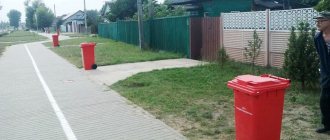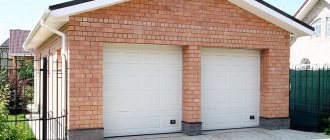As a result of life activity, many different wastes arise. This includes leftover food, construction waste, spoiled items, and deteriorated household equipment. To maintain cleanliness and order, municipal services are setting up a special container area for garbage.
Roll-out container site near an apartment building
As a rule, this is a small area with a low fence. Unlike a garbage chute, this method of storing waste also involves sorting waste, which simplifies the recycling process.
Types and types of waste container sites
There are two types of container sites:
- open, most common;
- closed;
- underground.
The cost of open-air structures is relatively low, and utilities use these.
Closed waste collection area with doors
A structure closed on all sides with a canopy and even doors is not seen very often. This is a more expensive option. Maintenance of such a site is paid for by residents of individual nearby houses or an organization.
The rarest type is a site with a waste storage area hidden underground. And on top there is only a garbage receptacle. Due to the high cost of construction and maintenance, you can rarely see them. It is advisable to use them to save space or to maintain an aesthetic appearance.
Served by special lifting machines
Outdoor waste bin
Underground garbage disposal with roll-out containers
Some garbage tends to decompose and attract animals and flies with its smell. Fire or infection may enter groundwater. To avoid unpleasant consequences, when constructing a waste container site, certain sanitary standards must be observed.
How to avoid theft
Missing trash cans are not uncommon. There are several defenses to prevent such problems.
- Installing a lock that allows you to lift the tank is possible only after it is unlocked.
- Recessed container.
- Company logo. It is applied by welding and allows you to quickly find the loss.
- A webcam that allows you to monitor both online and by viewing a recording.
- Signal beacon.
- Insurance.
Utility services are usually responsible for protecting trash cans from robbers. However, in some cases, residents of an apartment building are themselves interested in choosing a method that allows them to protect common property.
Requirements for MSW and MSW sites
First, let's understand the concepts of MSW and MSW. After the adopted amendments to the law “On Production and Consumption Waste”, the concept of MSW – municipal solid waste – appeared for the first time. The responsibility for storing and removing these raw materials was assigned to public utilities.
The bulk of the garbage in modern cities is ordinary household solid waste (MSW), which is generated daily: food debris, glass, plastic, cellulose, etc. Municipal waste (MSW) includes waste that accumulates in residential or non-residential premises during activities person or organization, for example, consumer goods that have lost their original purpose.
In the above-mentioned law, the terminology of MSW serves primarily to distinguish between types of waste and, accordingly, standards and tariffs for ordinary people and enterprises. It is obvious that entrepreneurs and organizations with large staff throw away much more garbage in the course of their activities than the average resident.
The organization of the container site is carried out by local utilities. When installing and maintaining these territories, they must be guided by the requirements enshrined in the instructions “Sanitary rules for maintaining the territory of populated areas SanPin 42-128-4690-88. These include:
- It is mandatory that in the area of residential buildings there must be special areas fenced on at least three sides. The height of the fence should be at least 1–1.5 m to prevent the wind from blowing debris into the nearby area. The location must be such that there is clear passage for the garbage truck. There should be no vegetation within a radius of 10 meters.
- Garbage containers must be located at a distance of at least 20 meters from residential buildings, children's and sports grounds, but no more than 100 meters.
- Garbage containers should be installed on a concrete or asphalt base at a height of 10–20 cm from the ground level so that rain streams do not fall under them. Sealable tanks are required.
- The number of storage bins depends on the number of houses located nearby. On average, the site size should accommodate from 3 to 5 waste containers.
- Garbage must be removed daily, and containers must be cleaned and treated with disinfectants at least once every 10 days, with the exception of winter.
- Possibility of installing covered fences for private sector owners.
Standards for placing garbage containers from residential buildings
SanPiN (or sanitary rules) are developed on the basis of scientific research and are designed for the safety of the population and their everyday amenities. That is why the distance to garbage cans from the house is not allowed, according to sanitary standards, less than 20 and more than 100 m.
If the distance between the house and the garbage container is less than the standard established by SanPiN, it does not fulfill its intended purpose.
But if the distance from the trash bin is greater, it creates inconvenience for residents who are forced to travel a considerable distance with garbage every day.
Different categories of the population live in apartment buildings, and it is especially difficult for older people to make such trips to the trash bin.
In 2021, the company that won the tender in this area should be responsible for the removal of waste and the maintenance of special containers in relative order. Previously, the head of the housing department of the administrative district was required to monitor the fulfillment of these duties (timely garbage removal, sanitation of garbage containers and areas for bins).
At least three participants in the process must decide how to locate sites with garbage containers - sanitary inspection authorities, the architectural department and the housing department. In situations where the norm indicating the proper distance from a garbage can or container to a residential building is, for some reason, impossible to implement, a decision is made by a special commission.
Regulatory acts
The distance from a garbage site to a residential building, both minimum and maximum, is regulated by several fundamental documents:
- SanPiN 1.2.2645-10 (sanitary and epidemiological rules and requirements), which was approved in 2010 by a special resolution of the Chief Sanitary Doctor of the Russian Federation.
- SanPiN 42-128-4690-88.
- SNiP, adopted at different times, determine the distances from individual housing construction located in the private sector, where compliance with standards is sometimes impossible to comply with.
- FZ-503 - changes in legislation adopted in December 2017, which came into force in 2021 and are better known as the Garbage Law - on a new procedure for storing and removing waste to landfills. In it, responsibilities for the removal of garbage waste are transferred to local authorities and a regional operator determined on a competitive basis (a company engaged in the removal and storage of various categories of waste, solid and household waste).
The distance from the house to the garbage site will be determined according to sanitary standards. The dump can be located at a distance from a residential building from 20 to 100 m and must comply with the listed distance standards.
The document specifies not only the required distance, but also the rules for installing waste bins on a specially equipped site, as well as the frequency with which it is necessary to empty garbage bins or solid waste containers.
Separate standards
SanPiN 42-128-4690-88 allows you to calculate the required number of special containers for waste: how many of them should be located in a certain area. The basis for calculations is the population size in a particular segment and the accumulation rates of various types of waste.
On private territory, the distance from the house to the containers, especially in SNT, where the area of the site is limited, the owner can reduce to 8 m by written agreement with neighbors or the board of the gardening partnership.
But this is only possible if the remaining distances are maintained in strict accordance with SNiP. The distance from the house to the garbage container cannot be limited to 8–10 m without special permission. And if the presence of a trash can causes complaints from owners of other land plots, the issue can be resolved in different ways:
- with the participation of independent and uninterested representatives of the public in resolving the issue;
- inviting a commission from the district administration to resolve the problem of distance from home;
- with the involvement of a deputy from the local council in resolving a controversial situation;
- in court, by filing a claim for an administrative violation, if the standards for placing garbage cans, garbage dumps or containers from the house contradict SNiP or SanPiN.
Location of trash cans and other norms of SNiP and SanPiN
In the latter case, grounds for a claim can be created in case of violation of the rules for the location of trash containers, and not just the distance norms. Container sites for garbage cans should not be located near pedestrian paths (even just narrow paths or passages), near the roadway or lawn, equipped according to the rules.
If construction work is underway in a house, the owner retains the right to install tanks or special containers for garbage in the private sector, but this is allowed for no more than a day, and only with the permission of the SES and regional architecture. The same rule applies to houses and public buildings when carrying out repairs or refurbishment to store waste.
Distance to playground
The distance to the playground from garbage cans is often the subject of numerous disputes and complaints to local authorities. There are no separate restrictions for this standard distance from the trash can, but in paragraph 2.2.
3 SanPiN 42-128-4690-88, a playground, sports ground and residential building (as well as recreational areas) cannot be located closer to a garbage dump than 20 m.
The norm for the location of garbage containers in all of the above cases ranges from a minimum of 20 to a maximum of 100 m.
Another requirement is also mandatory: the minimum and maximum limited distance from the house to the trash can or container should not include a children's playground, a sports ground, or even a recreation area. The only thing allowed to be located in close proximity to the trash can is a dog walking area.
But the bins cannot be placed next to a pedestrian path or next to a bicycle passage. For residential buildings in a densely built-up area, by decision of a special commission, this distance can be reduced to 9 m (this is the distance from the end or wall of the house, but not from the window of the residential premises and from the front entrance). Although according to SanPiN it cannot be less than 10 m.
Garbage dump near a residential building
The minimum distance can be maintained provided that places for garbage cans are specially equipped. For this, too, there are separate requirements - a fence on three sides, a place for the garbage truck to access, and tightly closing tank lids that prevent the spread of miasma. There must be a special warning sign on the fence.
Distance to public buildings
The sanitary safety of children is the main concern of supervisory authorities. Not every kindergarten is equipped with its own utility yard, to which access for a garbage truck is provided. But if there is one, its distance is considered from the closest pavilion or place reserved for children’s games.
The maximum distance norm can be calculated from the outermost door of the outbuilding. In any case, if the area for garbage cans is located behind the fence of the kindergarten, the distance to it cannot be less than 20 m, and the distance is measured not from the building, but from the fence.
Arrangement of waste storage areas
When constructing container sites, it is necessary to take into account the location and volume of daily waste. In residential areas and residential areas, places for collecting solid waste into 3 containers are optimally designed. In parks, near institutions, in the area of shopping centers, it is enough to have a site for 1-2 containers.
Article 8 of Russian Federation Law No. 89-FZ states who should install containers and should equip waste collection sites. According to this law, local governments are responsible for the development of sites.
The responsibility for purchasing and maintaining containers for waste accumulation lies with regional operators. Bunkers can also be purchased by owners of land on which MSW accumulation sites are located.
Legacies of the past are still found today
Equipment for container sites
There are several features to consider when constructing a waste disposal area:
- type of site - open or closed;
- size, if there is a need to install more than two tanks;
- take into account the need for the likely use of an additional bunker or roll-out container;
- types of garbage bin designs;
- manufacturing materials;
- external design of the site.
Recently, the prevailing trend is the arrangement of covered and completely enclosed container sites. They are considered more practical in providing protection from precipitation and wind. As a result, there is no need to purchase tanks with lids, because they are less durable during operation. In closed areas, regular waste bins can be used.
Containers can be made of various materials. But, it is better to choose plastic ones, as they are not afraid of dampness and their service life is much longer. Depending on the type of equipment for solid waste removal, you can purchase roll-out (on rollers) tanks.
If necessary, places with bunkers for collecting bulky waste can be arranged. Most often they are found in places where construction work is underway.
Maintenance of container sites and responsibility
According to government decree No. 290 of 04/03/2013, the responsibility for maintaining the sites lies with the owner of the land on whose territory it is located. Or at local government bodies: UO, housing cooperatives, residential complexes. Landscaping of waste sites consists of:
- maintenance – painting, repairs, etc.;
- cleaning, including the selection and storage of garbage located next to the tank;
- labeling containers by type of waste;
- cleaning and disinfection of waste bins;
- maintaining the coating in the required condition, etc.
Incorrect calculation of the size of the site and the number of tanks required.
For violation of the procedure for maintaining these places, the administrative and technical inspection applies a sanction in accordance with Art. 6.4 Code of Administrative Offenses of the Russian Federation Art. A fine of up to 2 thousand rubles is imposed on officials, and up to 20 thousand rubles for enterprises. The organization may face suspension of activities for up to 3 months.
Distance from garbage containers to a residential building: SanPiN and SNiP standards
In places where garbage is stored, rodents, cockroaches and other animals and insects gather, spreading various diseases.
To protect your home from unwanted neighbors, you must observe the distance from garbage containers to a residential building and other requirements of regulatory documents SanPiN and SNiP standards.
If stored improperly, waste can cause a fire, poison the air with toxic odors, and seep into groundwater.
Garbage cans near a residential building
Requirements for organizing space for garbage containers
The basic requirements for the distance to various objects and the organization of sites for containers are set out in SanPiN 42-128-4690-88. It states that the minimum distance from the house to the garbage container is provided for by sanitary standards and is 20 m. For ease of use, the maximum distance is also calculated.
Experts have determined that it is convenient to use garbage cans if they are located no further than 100 m. For greater distances, it is inconvenient to travel daily with a bag or bucket of waste.
The place for the container must be arranged properly.
A concrete or asphalt platform is made, protruding 100–200 mm above ground level. The tanks are placed on it. Water from the ground should not get into the containers after rain and increase the rotting of their contents.
On one side there is free space, a road equipped for a garbage truck passes through. It should be covered with gravel or have a hard surface that allows access in any weather. The area with containers must be fenced on the three remaining sides.
The number of garbage cans is calculated according to the number of citizens living in the house or two neighboring residential buildings for which the bins are installed. A maximum of 5 of them are allowed on one site.
As a recommendation, it is indicated not to place garbage cans on the side of the front entrance to the house. In addition, between the house and the garbage container there should not be:
- recreation areas;
- sports grounds;
- pedestrian and bicycle paths.
Near the place where the trash can is located, dogs and other animals are allowed to walk in designated areas. Owners must ensure that animals do not run into the area where garbage is stored.
Tanks are made of sheet metal or plastic. They must be sealed and durable, withstand the weight of a full load, and not be destroyed by acidic and alkaline solutions.
A hard and smooth bottom and side surface will not allow rodents to get inside in search of food. The volume of the containers is 2–4 cubic meters.
The containers have special sides or other devices for unloading waste into the machine.
Distance to residential building
Regardless of the type of building, if there are people living or working in it, SNiP and SanPiN determine a single standard, the minimum distance to garbage cans from the house, which is 20 m. A garbage dump should not poison the air in the rooms with its miasma and spoil the appearance of the yard.
Garbage removal rules
In order to protect residents from noise, it is allowed to remove solid waste from 7 a.m. to 11 p.m.
SanPiN 42-128-4690-88 strictly regulates the frequency of garbage removal in order to prevent it from rotting and decomposing. At air temperatures from +5 °C and below, the frequency of removal is 1 time every 3 days. During the warm season, when the average daily temperature is above +5 °C, garbage cans must be removed daily.
In case of violation of waste removal standards, you should file a complaint with the Rospotrebnadzor department, since supervision over the implementation of sanitary and epidemiological legislation is within its competence.
Places of historical buildings
In old neighborhoods with historical buildings, one building stands very close to another, often even they close the perimeter of the space around the yard. The minimum setback may be reduced to 9 meters. Tanks can be located under a blank wall in which there are no windows in living rooms.
In this case, the tanks should have lids and close tightly to prevent unpleasant odors from spreading throughout the yard.
Distances from the fence according to standards
In homes with garbage disposals, they should be emptied daily, garbage removed and disinfected to prevent the development of germs, insects and rodents.
Standards for installing containers in the private sector
For private sector owners, there are two ways to collect household waste:
- installation of a special container platform;
- purchase of roll-off waste containers.
Gardening partnerships, owners of summer cottages, garage-building cooperatives and rural residents independently choose the method of construction, types of repair and maintenance of solid waste collection sites. If the site is small and separate, each owner can choose and purchase from a regional operator at cost a roll-out waste storage tank.
Installed waste collection tank in the private sector
The site must be located at least 10 meters from personal plots, but not more than 100 meters. It is mandatory to have a fence for garbage containers, as there are more stray animals in the private sector.
Garbage removal in the private sector and rural areas is regulated by law. Thus, the law prohibits the installation of waste storage facilities at a distance of less than 9 meters from the passage of a gas main and a power plant. If there is a highway or railroad track nearby, the waste collection area is fenced off from the side of the highway and must be at least 20 meters away from the roads.
Removing waste from a site in rural areas
If the village is located near a forest or park area, then to install waste storage tanks you need to obtain a special permit from the regional operator.
By concluding an agreement with a legal organization, waste collection will be carried out in an organized manner. The rules and schedule for the removal of household waste are agreed separately with the service organization and are fixed in the contract.
After agreeing on all the conditions, the contractor arranges a solid waste collection site, removes garbage with a garbage truck, and regularly cleans and cleans the area. The payment consists of operator tariffs multiplied by the waste accumulation standard, using a seasonality factor.
Garbage removal
The owner of the private sector throws inorganic waste into a container, and can dispose of organic waste on his site.
For the removal of bulky waste and construction materials, it is necessary to conclude a separate agreement for disposal at tariffs for individual categories of waste.
Villages, urban settlements: features of waste collection
In villages and garden non-profit partnerships (SNT), people must collect garbage in areas specially designated for this .
It is prohibited to arrange spontaneous landfills on the territory or outside of such associations. Organic waste is disposed of directly in the garden or summer cottage. For the non-recyclable group (plastic, glass), it is necessary to create platforms and install containers.
Placement of containers in SNT
The minimum distance from the site to the boundaries of the plots is 20 m. This is prescribed in SaniPiN Resolution No. 18-51 of September 10, 1997.
A blind fence of at least 1 m in height is required on 3 sides If SNT or PGT is located next to railway tracks, containers must be installed at a distance of at least 20 m from them. On the road side, the site is also covered with a fence so that the local garbage dump is not visible from the train windows.
In SNT and similar associations, citizens themselves are responsible for the cleanliness of their area and the area around it. Managers must enter into an agreement with the contractor that carries out the removal of solid waste.
Important! Failure to comply with environmental or sanitary-epidemiological rules and the absence of an agreement between SNT and the regional operator will result in a fine. For example, in the Moscow region, the Rules “Regional standard for the maintenance and improvement of the territory of gardening associations” are in force, which stipulate specific amounts of fines (for SNT - 500 thousand rubles, for the chairman - 50 thousand, for members - 5 thousand).
The need to sort waste
Every year there is more and more garbage on the planet. The authorities of the countries allocate huge amounts of money for the construction of landfills for the collection of household waste, for which a huge area of clean land is allocated. Equipment and technologies for processing secondary raw materials are being improved.
However, the “garbage problem” remains. Under the sun's rays and downpours, mixed waste rots and releases toxic substances, poisoning the atmosphere, land and groundwater. Spontaneous combustion of this “explosive” mixture often occurs, causing even greater harm to the environment.
Carrying out “garbage” reform, on January 1, 2021, a new law on sorting waste before disposal came into force. At the same time, the presidential order on the creation was signed. Thus, the state took control of the processes of collection, storage and disposal of household waste.
Container site with separate waste collection
Indoor separate waste collection area for 4 containers
Many countries have been successfully using waste sorting systems for several years now. Citizens were required to sort garbage by dumping it in appropriate containers. The system for marking tanks for various waste has proven itself well. Depending on their purpose, they may have different colors or inscriptions. The relevant housing and communal services are required to install such containers separated by type of waste.
At the household level, it is customary to sort waste according to its intended purpose:
- glass products;
- packaging and bottles for juices and canned goods made of metal;
- packaging paper, newspapers, cardboard and other cellulose items;
- textile products;
- leftover food;
- deteriorated batteries, batteries, LED lamps, etc.
For convenience, so that going to the container does not turn into an unpleasant procedure, it is better to sort the garbage at home, placing it in bags or containers in advance.
The process of sorting waste can be called a noble cause, since by spending a little time, everyone will contribute their bit of care for the environment and the planet as a whole.









